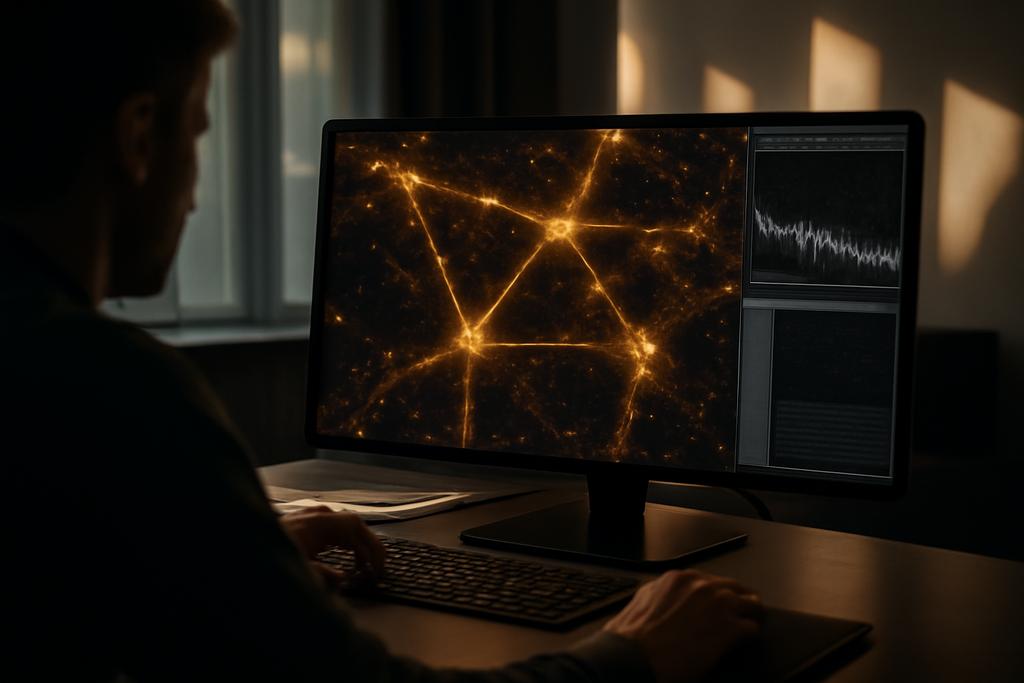The universe isn’t a smooth ocean of galaxies. It’s more like a vast, lopsided foam of filaments, knots, and empty pockets—a cosmic web stitched together by gravity over billions of years. Our best map of that web comes not from directly seeing matter, but from watching how light is absorbed as it travels to us. In the spectra of distant quasars, a forest of absorption lines—the Lyman-α forest—tells the story of hydrogen gas scattered along the line of sight. These tiny shadows, embedded in photons traveling across the cosmos, encode clues about how matter clumps on small scales and how the universe evolved at redshifts greater than two. The new work behind Lya2pcf, led by Josue De-Santiago, Rafael Gutiérrez-Balboa, Gustavo Niz, and Alma X. González-Morales, sits at this intersection of elegant physics and heavy computation. It is a milestone not just in what we can measure, but in how efficiently we can measure it. The study comes out of the physics departments at the Centro de Investigación y de Estudios Avanzados del IPN (CINVESTAV) and the Universidad de Guanajuato in Mexico, and it centers on a pipeline that maps two- and three-point correlations in the Lyman-α forest with unprecedented speed and scope.
Two things matter here. First, higher-order statistics—the three-point function in particular—carry information that the classic two-point function can miss. They’re sensitive to the nonlinearity of gravity, the subtle fingerprints of the intergalactic medium, and potential new physics that would tweak how matter clusters as it evolves. Second, the scale of modern surveys—SDSS, DESI, and its ambitious Year-5 mocks—produces enough data that we can only reach the full scientific potential if we push computing to the limit. Lya2pcf is designed to do just that: accelerate the heavy lifting of estimating both two-point and three-point correlations, including the tricky distortion effects that arise when you estimate the quasar continuum, and then do it on GPUs so the math can keep up with the data explosion. This isn’t just an incremental improvement; it’s a shift in how we can squeeze physics from the light that travels across the universe.
The authors make clear that GPU acceleration isn’t cosmetic. It is the enabling technology that lets them push into the realm of the 3PCF (three-point correlation function) for Ly-α forests on datasets that would have taken prohibitively long to analyze with traditional code. And that matters because higher-order statistics are where some of the interesting, non-Gaussian storytelling lives. The 3PCF can reveal subtle interactions and nonlinearities in the density field that two-point statistics smooth over. In short, Lya2pcf is a tool that aims to sharpen our cosmic map by adding a new type of texture to the picture, not just a crisper outline.
In the sections that follow, we’ll walk through what the Lyman-α forest is, why two- and three-point correlations matter, how the Lya2pcf pipeline works under the hood, what the authors actually measured in real data, and what this could mean for the next era of cosmology with Stage IV spectroscopic surveys like DESI. We’ll also highlight the human story behind the numbers—the collaboration across institutions, the dance between theory and computation, and the bold bet that higher-order statistics can unlock new physics in the high-redshift universe.
The work is a reminder that even in a field as data-rich as modern cosmology, there’s room for a fresh perspective. The Lyman-α forest has long been a powerful probe of small-scale physics in the early universe, but two challenges have loomed large: how to compute the statistics efficiently and how to extract the richest possible information without getting drowned in combinatorics. The authors’ answer is a pipeline that treats the Ly-α fluctuations as a field built from many quasar sightlines, stitches them together with Healpix-based neighborhood logic, and unleashes GPU-accelerated histograms to tally pairwise and triplet correlations. It’s a technical triumph with a simple, almost architectural elegance: turn a sky full of sightlines into a three-dimensional mosaic, then read the mosaic with a speed that matches the scale of the data itself.
Before we dive in, it’s worth naming the names behind the work. The study was led by Josue De-Santiago, Rafael Gutiérrez-Balboa, and Alma X. González-Morales, with central affiliations at the Centro de Investigación y de Estudios Avanzados del IPN (CINVESTAV) in Mexico and the Universidad de Guanajuato. Their collaboration brings together a tradition of precise, careful measurements of the intergalactic medium and a contemporary touch of high-performance computing that pushes the field forward. The scientific question remains timeless: how did gravity sculpt the universe’s web, and what can the patterns of light and shadow tell us about the physics at play on scales we can barely dream of? The Lya2pcf work is one of the clearest steps yet toward answering that question with the full power of modern data and modern machines.










